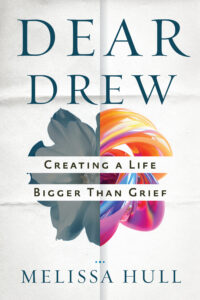
Melissa Hull is an internationally recognized voice in grief recovery, particularly for parents healing from child loss. Her book Dear Drew: Creating a Life Bigger Than Grief was published by Health Communications, Inc., in August 2025. From the book description:
When Hull lost her four-year-old son, Drew, in a drowning accident, shock gave way to consuming guilt and emotional paralysis. She struggled to move forward and couldn’t imagine a future, until a message from a stranger gave her a gentle nudge and a glimmer of hope. As she slowly rebuilt her life, she realized a critical truth: Healing is a choice that requires active participation.
This was an important book to write, and I was honored to help revise it, but it was definitely not an easy book to write. In fact, here’s part of what Melissa said in her testimonial:
“I found an agent, and she sent me to Karin, who told me I needed to tear apart the original manuscript and rewrite it. Can I just say how soul crushing it was to do that?”
Aack, I am so mean! Why would I say the manuscript needed to be rewritten?
Because this book about grief and healing contained lots of tactics but very few emotions. The original manuscript read like a collection of “live your best life” blog posts. There is nothing wrong with books that encourage you to bring your best self forward, but I knew Melissa had a much deeper message to convey.
We used many tools to reorganize and deepen the content—interviews and talking, affinity mapping, stories and imagery—but one tool became our overarching guide as we revised: emotional anchors—words that reminded us of the emotional experience we wanted readers to have as they read the book.
Here I want to describe the concept, show you how our chosen anchors guided us (and evolved as we proceeded), and then how they were reflected in the final book.
The Concept: Using Emotional Anchors to Focus on the Reader’s Experience
As writers, we can choose guiding words that keep us focused on the emotional touchpoints of our work. These words function as cues that remind us of the reader experience, helping us make choices about structure, stories, tone, and depth of explanation. In short, using these emotional anchors is a way of staying in tune with the reader and shaping the experience we want them to have.
For example, in Stephanie Scotti’s Talk on Water, a book about giving high-stakes presentations, buoyant was the guiding word. Buoyant led to a focus on clarity of concept, less dense text, and an open, approachable tone. Imagine if we had chosen grounded or intentional instead—each would have shaped the book and thus the reader’s experience of it in a very different way.
What does using a guiding word look like in practice? For me, I sit quietly and meditate on the word for a few minutes. I pull it into my psyche. Then as I write or revise, I hold that feeling in my body. As a result, I can more easily see what text aligns with the intended feeling and what does not.
How Emotional Anchors Worked with Dear Drew
Looking back over my notes from about 16 months of revision, here’s how this process played out with Dear Drew:
When I first asked Melissa how she wanted her readers to feel, the words that came up were guided, supported, led, held. She quickly realized that the initial draft had not fully considered the reader’s perspective—this was a big aha for revision.
Our emotional anchors and the aha led to some structural decisions: Each chapter would start with a story, follow with a teaching (the concept illustrated by the story), and end with a practical tool.
As we worked on a few chapters, we noticed that readers needed to be led lightly, as emotional deep dives early on might be overwhelming. The tools needed to be simple, straightforward, and easily tried in the moment.
Next, we realized that in the first part of the book, readers needed to feel seen. Melissa needed to be present with them. If the readers felt witnessed, they would keep reading, and if they didn’t, we’d lose them. In assessing an early draft, we decided readers would not feel seen enough—which led to more revision.
Our anchors then became seen, held, safe, led. With further work and revision, they shifted to seen, held, supported, led.
Then Melissa realized the final part of the book really required a word like inspired or lifted to take the reader through the transformational idea of creating a life bigger than grief—and the last part of the book was missing the mark. More revision…
Even as the words evolved over time, the concepts remained consistent: Our anchors helped ensure readers felt witnessed, supported, and (we hope) transformed in their healing journey.
Emotional Anchors in Action: Dear Drew’s Final Structure
As the book was revised, it evolved into four distinct parts, each with 5 to 7 chapters, as well as a brief introduction that set the stage for the part. Here I want to show you the emotional anchors most relevant to each part as well as the imagery we chose for the introductions and some sample language that reflects the emotional touchpoint.

Part 1: Discover Your Agency
In this section, readers learn to reframe their relationship with pain and healing, and discover their ability to choose to heal.
- Emotional Anchor: Seen, held
- Chapters: Hope, Comfort, Preparation, Progress, Acceptance, Agency
- Imagery: Grief is like being at sea amidst a squall—how do you get to shore?
- Language: “Exhausted and alone, you may not know where to go next. That’s when I want you to look for a lighthouse and point your bow toward its steady glow. Your lighthouse can be a person, therapy, or even this book. I am in the lighthouse. I see you, and I won’t leave you alone in those waters.”
Part 2: Acquire New Tools
In this section, readers prepare for difficult emotional work by gathering tools that align with their healing needs.
- Emotional Anchor: Held, supported
- Chapters: Inner Voice, Expression, Energy, Nature, Connection
- Imagery: Your old tools for “gardening” your life have splintered; you must find new tools to deal with the tangle in front of you.
- Language: “I will not send you into rough terrain unequipped. Before you lower to hands and knees, I will remind you to slip on your protective gloves and reach for new tools: a sturdy trowel for loosening what feels unmovable, a pruner for cutting away what no longer serves you, a watering can for nourishment when grief asks too much.”
Part 3: Face the Tough Stuff
In this section, readers look at healing difficult emotional wounds—which includes the presenting loss or trauma as well as even deeper ones.
- Emotional Anchor: Supported, led
- Chapters: Awareness, Grace, Ownership, Narratives, Meaning, Empathy
- Imagery: Healing is like sticking your hand in a mess of fishhooks—they are all entangled and each one pricks, but removing them feels good.
- Language: “I will not ask you to labor alone—and I would never urge you to risk the barbs unless I had endured them first. I promise to remind you how transformative this work is each time you reach into the bowl. Healing is not easy, but it is yours to claim. So when you’re ready, reach in. One hook at a time. One choice at a time. Keep going.”
Part 4: Create a Life Bigger Than Grief
In the final section, readers look for the gifts that can come from their pain and learn how choosing to heal can lead to a beautiful, integrated life.
- Emotional Anchor: Led, inspired
- Chapters: Service, Exploration, Spirituality, Purpose, Vision, Self-Trust, Love
- Imagery: Grief feels like shards of broken glass, but as you heal, you put the pieces into a kaleidoscope and start to see their beauty; eventually the pieces fuse into something both fluid and strong.
- Language: “You are no longer just observing the pieces—you are living them. They become part of you, deepening your capacity for joy, resilience, and purpose. One piece teaches you strength, another compassion; together, they reveal how love and loss can coexist. Like a piece of hand-blown glass, your life becomes an artful expression of your experience. It is beautiful, unique, and entirely yours.”
Did the Emotional Anchors Work?
Melissa reflected:

“My message was deepened and refined. I was deepened and refined. … Doing this work has given me a new confidence. I have so much excitement about what is next. We found a publisher faster than I ever expected… I am ready to share [my book], I know it has meaning, and I am fully committed to it. This is how I know my life has become bigger than grief.”
But the real test is the readers. Here are a few snippets from early reviews:
- “Melissa Hull’s journey from unimaginable pain to purposeful healing is inspiring and empowering.”
- “Dear Drew is a profound and compassionate companion for anyone navigating the depths of grief.”
- “With raw authenticity and deep wisdom, she reveals the hidden blessings within grief, guiding us toward a spiritual understanding that transcends pain and leads to growth.”
- “This book is a deeply transformative gift for anyone seeking not just comfort, but the courage and tools to grow and thrive after loss.”
- “Melissa’s vulnerability and courage make you feel less alone, and her words offer comfort while also challenging you to grow.”
While the precise emotional cues might not be repeated—seen, held, supported, led, inspired—they are certainly echoed.
Give Emotional Anchors a Try
If you are working on a book project, take some time to consider the emotional experience you want your readers to have.
- Identify three words that capture those experiences.
- Sit quietly with those words and imagine yourself as the reader.
- Read your manuscript through the lens of these words. What aligns? What doesn’t?
- Revise accordingly.
I promise your readers will feel the difference.
The type of work I did with Melissa is intense, intimate, and transformative. If you have a book project that requires that type of support, let’s talk to see if we are a good fit. Get in touch at karin@clearsightbooks.com.

